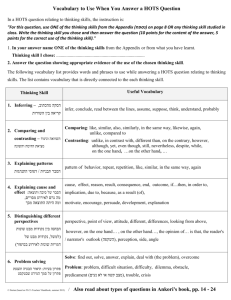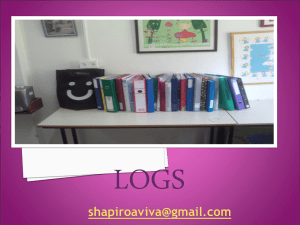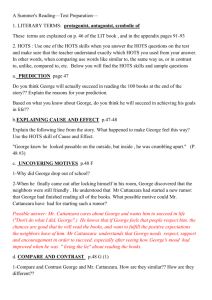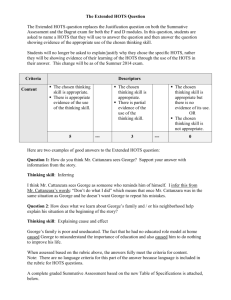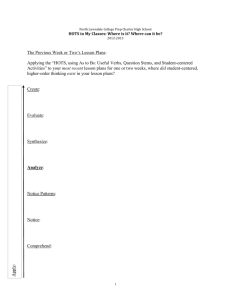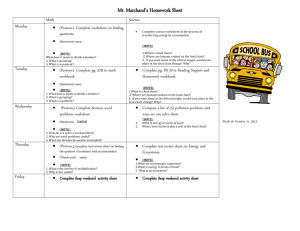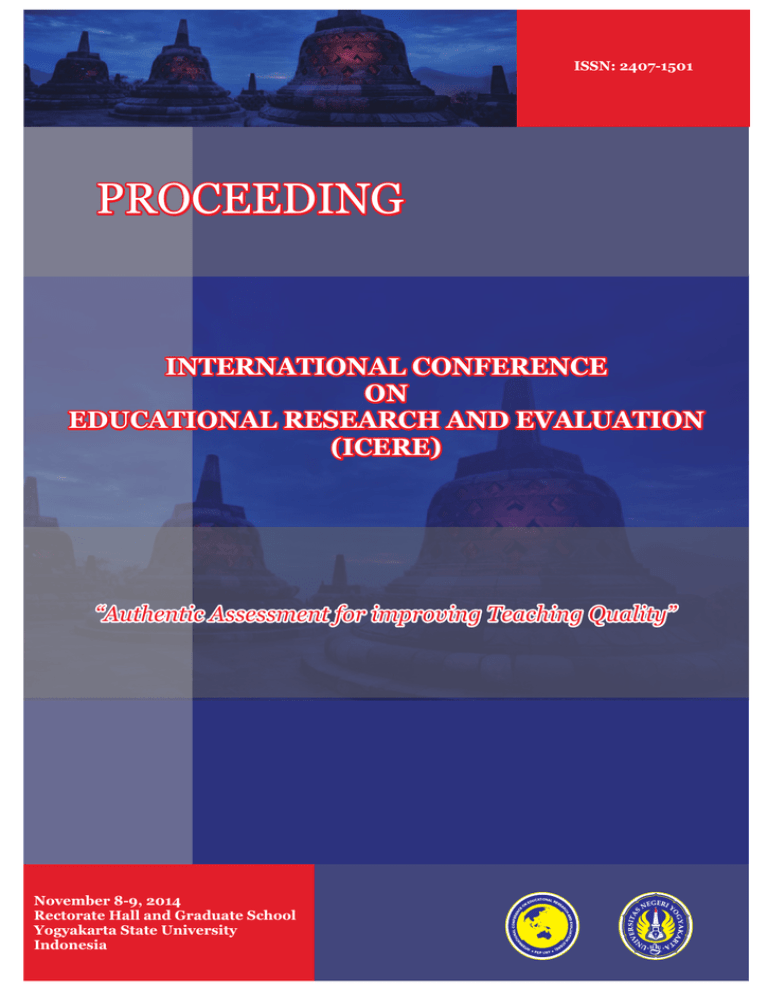
ISSN: 2407-1501
PROCEEDING
INTERNATIONAL CONFERENCE
ON
EDUCATIONAL RESEARCH AND EVALUATION
(ICERE)
“Authentic Assessment for improving Teaching Quality”
November 8-9, 2014
Rectorate Hall and Graduate School
Yogyakarta State University
Indonesia
Organized by:
Doctoral and Master’s Program in
Educational Research and Evaluation
Graduate School, Yogyakarta State University
Proceeding
International Conference on Educational Research and Evaluation (ICERE) 2014
Publishing Institute
Yogyakarta State University
Director of Publication
Prof. Djemari Mardapi, Ph.D.
Board of Reviewers
Prof. Djemari Mardapi, Ph.D.
Prof. Dr. Badrun Kartowagiran
Prof. Dr. Sudji Munadi
Prof. Dr. Trie Hartiti Retnowati
Dr. Heri Retnowati
Dr. Widihastuti
Editors
Ashadi, Ed.D.
Suhaini M. Saleh, M.A.
Titik Sudartinah, M.A.
Lay Out
Anggit Prabowo, M.Pd.
Rohmat Purwoko, A.Md.
Address
Yogyakarta State University
ISSN: 2407-1501
@ 2014 Yogyakarta State University
All right reserved. No part of this publication may be reproduced without the prior written
permission of Yogyakarta State University
All artices in the proceeding of International Conference on Educational Research and
Evaluation (ICERE) 2014 are not the official opinions and standings of editors. Contents and
consequences resulted from the articles are sole responsibilities of individual writers.
BACKGROUND
In its effort to improve the quality of education in Indonesia, the
Indonesian government has imposed Curriculum 2013 on schools of all level in
Indonesia. The main difference between Curriculum 2013 and the previous
curriculum lies in its implementation which uses the scientific approach. For the
reason, teachers need to develop teaching strategies different from those they used
to apply in the implementation of the previous curriculum. Besides, teachers also
need to develop the techniques of evaluating students’ learning achievement,
which are relevant to the scientific approach. The evaluation has to be able to
show the students’ learning achievement in observing, experimenting, social
networking, etc.
Authentic assessment conducted in the classroom and focusing on
complex and contextual tasks enables students to perform their competence in a
more authentic arrangement. It is very relevant to the authentic approach
integrated in their teaching process, especially at elementary schools, or for
appropriate lessons. It must be able to show which attitude, skill, and knowledge
have or have not been mastered by the students, how they use their knowledge,
what aspect they have or have not been able to apply, and so on.
On the basis of the above consideration, teachers can identify what materials the
students can study further and for what material they need to have a remedial
program. Authentic assessment, however, is not that easy!
FOREWORD
In the academic year of 2014, the government in this case the Ministry of
Education and Culture has established the policy to run the curriculum of 2013 for
the all levels of elementary and intermediate education in Indonesia. It means the
schools have to be ready to implement the Curriculum of 2013. Basically, the
implementation of the 2013 curriculum is an effort from the government to
enhance the quality of education.
One of the characteristics of the 2013 curriculum is make use the scientific
approach in the learning process. This approach is to improve the students’
creativity in learning. In general, this approach seems to be a new thing for the
teachers in which several problems and obstacles appear in its practice. The
teachers are required to develop the learning strategies and the assessment
systems which are relevant and appropriate in order to nurture the students’
creativity. One of the assessment methods that can support the concept of
scientific approach is by sing the authentic assessment. Authentic assessment can
give the description of the knowledge, the attitudes, and the skills as well as what
has or has not owned by the students and the way they apply their knowledge.
Also, in what case they have or have not been able to implement the learning
acquisition.
Based to the above circumstances, the Study Program of Educational
Research and Evaluation, Graduate School of Yogyakarta State University
(Universitas Negeri Yogyakarta) conduct the international seminar on the theme
“Classroom Assessment for Improving Teaching Quality”. There will be three
sub-themes on this seminar, i.e. Issues of Classroom Assessment Implementation,
Implementation of Authentic Assessment, and Developing a Strategy of Creative
Teaching. By having this seminar, the participants are expected to possess the
knowledge and the skills to develop and to apply the authentic assessment.
Yogyakarta, November 8, 2014
Head of Committee
Prof. Dr. Sudji Munadi
CONTENTS:
Title …………………………………………………………………………
Background …………………………………………………………………
Foreword ………………..………………………………………….……….
Welcome Speech …………………………………............……...………….
Preface …………………………………………………….. ………………
Content ………………………………………………………………….…..
pages
i
ii
iii
iv
v
vi
Invited Speaker
2
ISSUES OF CLASSROOM ASSESSMENT IMPLEMENTATION
Madhabi Chatterji ……………………………………………….………….
IMPLEMENTATION OF AUTHENTIC ASSESSMENT
Pongthep Jiraro………………………………………………….…………..
11
DEVELOPING A STRATEGY OF CREATIVE TEACHING
23
Paulina Panen…………………………………………………….………….
Paper Presenter
Theme 1:
Issues of Classroom Assessment Implementation
ASSESSMENT IN DEVELOPMENT COMPUTER-AIDED
INSTRUCTION
Abdul Muis Mappalotteng …………………………………………………
35
THE MEASUREMENT MODEL OF INTRAPERSONAL
AND INTERPERSONAL SKILLS CONSTRUCTS
BASED ON CHARACTER EDUCATION
IN ELEMENTARY SCHOOLS
Akif Khilmiyah……………………………………………………………..
47
LEARNING ASSESSMENT ON VOCATIONAL SUBJECT MATTERS
OF THE BUILDING CONSTRUCTION PROGRAM OF THE
VOCATIONAL HIGH SCHOOL IN APPROPRIATE TO
CURRICULUM 2013
Amat Jaedun ………………………………………………………………..
63
ACCURACY OF EQUATING METHODS FOR MONITORING THE
PROGRESS STUDENTS ABILITY
Anak Agung PurwaAntara …………………………………………………
74
Proceeding International Conference on Educational Research and Evaluation (ICERE) 2014
iv
EFFECT OF PERFORMANCE ASSESSMENT ON
STUDENTS’THE ACHIEVEMENT IN PHYSICS HIGH SCHOOL
Aswin Hermanus Mondolang ……………………………………………...
86
TEST ITEM ANALYSIS PROGRAM DEVELOPMENT WITH RASCH
MODEL ONE PARAMETER FOR TESTING THE ITEM DIFFICULTY
LEVEL OF MULTIPLE-CHOICE TEST USING BLOODSHED DEV C
++ APPLICATIONS
Dadan Rosana, Otok Ewi Amsirta …………………………………………
93
EFFECTIVENESS OF REASONED OBJECTIVE CHOICE TEST
TO MEASURE HIGHER ORDER THINKING SKILLS IN PHYSICS
IMPLEMENTING OF CURRICULUM 2013
Edi Istiyono, Djemari Mardapi, Suparno …………………………………
101
DEVELOPING STUDENTS’ SELF-ASSESSMENT AND STUDENTS’ PEERASSESSMENT OF THE SUBJECT-MATTER COMPETENCY OF
PHYSICS EDUCATION STUDENTS
111
Enny Wijayanti, Kumaidi, Mundilarto ……………………………………..
THE RESULT OF ASSESSMENT FOR STUDENTS IN SOLVING
EXPONENTS AND LOGARITHMS PROBLEMS (CASE STUDY IN
GRADE X CLASS MATHEMATICS AND NATURAL SCIENCE (MIA)
2 STATE SENIOR HIGH SCHOOL 1 DEPOK 2014/2015)
Fajar Elmy Nuriyah ………………………………………………………..
123
RELIABILITY RANKING AND RATING SCALES OF MYER AND
BRIGGS TYPE INDICATOR (MBTI)
131
Farida Agus Setiawati …………………………………………………………….
THE COMPARISON OF ITEMS’ AND TESTEES’ABILITY
PARAMETER ESTIMATION IN DICHOTOMOUS AND POLITOMUS
SCORING (STUDIES IN THE READING ABILITY OF TEST OF
ENGLISH PROFICIENCY)
Heri Retnawati ……………………...………………………………………
139
STUDENTS’ CHARACTER ASSESSMENT AS A REFERENCE IN
TEACHING LEARNING PROCESS AT SMPK GENERASI UNGGUL
KUPANG
KorneliusUpa Rodo, Netry E.M. Maruckh, Joko Susilo …………………..
151
MEASUREMENT ERROR ESTIMATION OF CUT SCORE OF
ANGOFF METHOD BY BOOTSRATP METHOD
Sebastianus Widanarto Prijowuntat ………………………………………..
157
Proceeding International Conference on Educational Research and Evaluation (ICERE) 2014
v
THE ACTUALIZATION OF PROJECT-BASED ASSESSMENT IN
ENTREPRENEURSHIP EDUCATION BASED ON LOCAL
EXCELLENCE IN MEASURING SKILLS OF VOCATIONAL HIGH
SCHOOL STUDENTS
Sukardi ……………………………………………………………………..
168
THE EFFECTIVENESS OF THE USE OF THE INSTRUMENTS AND
177
RUBRICS OF CREATIVE THINKING SKILLS–BASED ASSSESMENT
PROJECT IN THE LEARNING OF CONSUMER EDUCATION
Sri Wening ………………………………………………………………….
PROJECT WORK USED IN A COMPREHENSIVE ASSESSMENT
TO MEASURE COMPETENCES OF UNDERGRADUATE
ENGINEERING STUDENTS
Sudiyatno……………………………………………………………………
194
THE DEVELOPMENT OF A SET OF INSTRUMENT FOR STUDENT
PERFORMANCE ASSESSMENT
Supahar …………………………………………………………………….
202
DEVELOP MODEL TASC TO IMPROVE HIGHER ORDER
THINKING SKILLS IN CREATIVE TEACHING
Surya Haryandi ……………………………………………………………..
210
THE EFFECT OF NUMBER’S ALTERNATIVE ANSWERSON
PARTIAL CREDIT MODEL (PCM) TOWARDESTIMATION RESULT
PARAMETERS OF POLITOMUS ITEM TEST
Syukrul Hamdi ……………………………………………………………..
216
THE CONTENT VALIDITY OF THE TEACHER APTITUDE
INSTRUMENT
Wasidi ….…………………………………………………………………...
227
DEVELOPING COGNITIVE DIAGNOSTIC TESTS ON LEARNING OF 233
SCIENCE
Yuli Prihatni ……………………………………………………………….
DIAGNOSTIC MODEL OF STUDENT LEARNING DIFFICULTIES
BASED ON NATIONAL EXAM
Zamsir, Hasnawati .…………..…………………………………………….
246
DEVELOPMENT OF A MODEL OF ACADEMIC ATTITUDE AMONG
SENIOR HIGH SCHOOL STUDENTS
Sumadi ........................................................................................................
258
Proceeding International Conference on Educational Research and Evaluation (ICERE) 2014
vi
Theme 2:
Implementation of Authentic Assessment
IMPLEMENTATION OF AUTHENTIC ASSESSMENT OF
CURRICULUM 2013 AT STATE ELEMENTARY SCHOOLS IN
PABELAN
Abdul Mu’in, NiningMarianingsih, WoroWidyastuti …………………….
265
AUTHENTIC ASSESSMENT OF STUDENT LEARNING
MATHEMATICS WITH TECHNOLOGY
Ida Karnasih ……………………………………………………………….
278
AUTHENTIC ASSESSMENT : UNDERSTANDING LEVELS AND
CONSTRAINTS IN THE IMPLEMENTATION OF THE TEACHER IN
THE CITY OF LHOKSEUMAWE ACEH PROVINCE
M. Hasan …………………………………………………………………..
286
AUTHENTIC ASSESSMENT DETERMINANT IN ISLAMIC
RELIGION EDUCATION EXECUTION TOWARDS COGNIZANCE
QUALITY HAVES A RELIGION IN STUDENT AT ELEMENTARY
SCHOOL AND MADRASAH IBTIDAIYAH AT KUDUS REGENCY
Masrukhin ......................................................................................................
295
AUTHENTIC ASSESSMENT FOR IMPROVING TEACHING
QUALITY: PORTFOLIO AND SLC IN PAPUA HARAPAN SCHOOL
Noveliza Tepy, Sabeth Nuryana, Putri Adri ……………………………….
307
Theme 3:
Developing a Strategy of Creative Teaching
THE EFFECT OF MATH LESSON STUDY IN TERMS OF
MATHEMATICS TEACHER’S COMPETENCE AND MATH
STUDENT ACHIEVEMENT
‘AfifatulMuslikhah ………………………………………………………...
319
AN EVALUATION OF THE ENGLISH TEACHING METHODS
IMPLEMENTED AT BUJUMBURA MONTESSORI PRIMARY
SCHOOL: WEAKNESSES AND ACHIEVEMENTS
Alfred Irambona …………………………………………………………...
323
TEAMS GAME TOURNAMENT FOR IMPROVING THE STUDENTS’
INTEREST TOWARD MATHEMATICS
Anggit Prabowo …..………………………………………………………..
331
Proceeding International Conference on Educational Research and Evaluation (ICERE) 2014
vii
DEVELOPING LEARNING KIT TO IMPROVE HOTS FOR FLAT SIDE 346
OF SPACE COMPETENCE
Arifin Riadi …………………………………………………………………
DEVELOPMENT STRATEGYOF TEACHERS’ TEACHING
PROFESSIONALISM
Bambang Budi Wiyono ……………………………………………………
352
THE EFFECT OF QUESTION PROMPTS AND LANGUANGE
ABILITY ON THE QUALITY OF THE STUDENT’S ARGUMENT
BambangSutengSulasmono, HennyDewiKoeswanti ………………………
364
THE USE OF RESPONSE ACTIVITIES IN DEVELOPING READING
SKILLS AMONG INTERMEDIATE EFL STUDENTS
Beatriz Eugenia Orantes Pérez …………………………………………….
378
COMPARISON OF THE EFFECTIVENESS OF CONSTRUCTIVISM
389
AND CONVENTIONAL LEARNING KIT OF MATHEMATICS
VIEWED FROM ACHIEVEMENT AND SELF CONFIDENCE OF
STUDENTS IN VOCATIONAL HIGH SCHOOL (AN EXPERIMENTAL
STUDY IN YEAR XI OF SMK MUHAMMADIYAH 2
YOGYAKARTA)
DwiAstuti, Heri Retnawati ………………………………………………...
THE EFFECT OF CLASS-VISITATION SUPERVISION OF THE
SCHOOL PRINCIPAL TOWARD THE COMPETENCE AND
PERFORMANCE OF PANGUDI LUHUR AMBARAWA
ELEMENTARY SCHOOL TEACHERS
Dwi Setiyanti, Lowisye Leatomu, Ari Sri Puranto, Theodora Hadiastuti,
Elsavior Silas………………………………………………………………..
394
THE ‘REOP’ ARCHITECTURE TO IMPROVE STUDENTS
LEARNING CAPACITY
Edna Maria, Febriyant Jalu Prakosa, Christiana, Monica Ganeip Pertiwi ....
403
E-LEARNING-BASED TRAINING MODEL FOR ACCOUNTING
TEACHERS IN EAST JAVA
Endang Sri Andayani, Sawitri Dwi Prastiti, Ika Putri Larasati, Ari Sapto ...
408
CONCEPT AND CONTEXT RELATIONSHIP MASTERY LEARNING 431
AND THE RELATIONSHIP BETWEEN BIOLOGY AND PHYSICS
CONCEPT ABOUT MANGROVE FOREST
Eva Sherly Nonke Kaunang ………………………………………………..
Proceeding International Conference on Educational Research and Evaluation (ICERE) 2014
viii
THE EFFECTIVENESS OF TEACHING MULTIMEDIA ON TOPIC OF
THREE DIMENSIONS IN TERMS OF THE MATHEMATICS
LEARNING ACHIEVEMENT AND INTEREST OF STATE SENIOR
HIGH SCHOOL
Lisner Tiurma, Heri Retnawati …………………………………………….
439
BUILDING THE STUDENT CHARACTER THROUGH THE
ACADEMIC SERVICE
M. Miftah …………………………………………………………………..
448
THE TEACHING EVALUATION OF GERMAN TEACHER IN
MALANG
Primardiana Hermilia Wijayati ......................................................................
464
SUPPORTING PHYSICS STUDENT LEARNING WITH WEB-BASED 479
ASSESSMENT FOR LEARNING
Sentot Kusairi, Sujito ……………………………………………………….
AMONG LEARNING AS A CULTURE BASED LEARNING OF TAMAN
MUDA TAMAN SISWA AS CONTRIBUTION TO THE LEARNING
PROCESS OF 2013 CURRICULUM AND CHARACTER EDUCATION
OF THE NATION
Siti Malikhah Towaf ………………………………………………………..
490
THE PERFORMANCE OF THE BACHELOR EDUCATION INSERVICE TEACHERS PROGRAMME (ICT-BASED BEITP)
BACHELOR GRADUATED AND ITS DETERMINANT
Slameto …………………………………………………………………….
513
DEVELOPING LEARNING TOOLSOF A GAME-BASED LEARNING
THROUGH REALISTIC MATHEMATICS EDUCATION (RME) FOR
TEACHING AND LEARNING BASED ON CURRICULUM 2013
Sunandar, Muhtarom, Sugiyanti ….………………………………………...
525
PREPARATION OF COMPUTER ANIMATION MODEL FOR
LEARNING ELECTRICAL MAGNETIC II PHYSICAL EDUCATION
PROGRAM STUDENTS SEMESTER IV TEACHER TRAINING AND
EDUCATION FACULTY SARJANAWIYATA TAMANSISWA
UNIVERSITY 2014
Sunarto ……………………………………………………………………...
536
IMPROVEMENT ACTIVITIES AND STUDENT LEARNING
OUTCOMES IN READING COMPREHENSION THROUGH
COOPERATIVE LEARNING TYPE TEAMS-GAMES-TOURNAMENT
(TGT) CLASS V SD NEGERI 8 METRO SOUTH
Teguh Prasetyo, Suwarjo, Sulistiasih ………………………………………
547
Proceeding International Conference on Educational Research and Evaluation (ICERE) 2014
ix
PSYCHOLOGICAL FACTOR AFFECTING ENGLISH SPEAKING
PERFORMANCE FOR THE ENGLISH LEARNERS IN INDONESIA
Youssouf Haidara ………………………………………………………….
Proceeding International Conference on Educational Research and Evaluation (ICERE) 2014
558
x
DEVELOPING LEARNING KIT TO IMPROVE HOTS
FOR FLAT SIDE OF SPACE COMPETENCE
Arifin Riadi1, Heri Retnawati2
Mathematics Education of GSPYSU, Yogyakarta State University
arifinriadi19@gmail.com1, retnawati.heriuny1@gmail.com2
Abstract
This research was aimed to develop a learning kit for flat side of space
competence to improve higher-order thinking skills using problem-based learning,
consisting of valid, practical, and effective syllabuses, lesson plans, worksheets, and the valid
and reliable of evaluation instrument i.e. test. The research is a development research
(research & development), which was carried out by the implementation of Borg & Gall
(1983) development model, which modified into three stages: preliminary study, product
design, and development and evaluation. The result of validation by expert jugdement shows
that the developed learning kit is feasible to use with valid category. The aspects of
practicality was falls into practical category based on observation of learning implementation,
and teacher‘s and student‘s assessment. The aspect of effectiveness could be reached from the
student‘s HOTS. The result of field tryout shows that student‘s HOTS category gets A at
SMP Negeri 1 Daha Utara and B at SMP Negeri 2 Daha Utara.
Keywords: development, higher-order thinking skills, problem-based learning
Introduction
Higher-order thinking skills (HOTS) was really important for students because the
characteristic of real life problems was complex, illstructured, novel, and needs thinking
skills more than just aplicates what was studied. Students should be creative for making
solutions of the problems what they faces in society. On the other hand, in UU number 20
year 2003 section 3 clarifed that one of the functions and purposes of national education is
developing student‘s potential to become human that have devout and pious to the one and
only God, kind character, healthy, scholarly, skillful, creative, stand alone, and become
democratic and responsible citizen.
Based on those laws, it‘s clearly known that higher-order thinking skills or we called
HOTS of student‘s potential should be developed and improved. So, learning activity should
be focus on reaching those HOTS.
Curriculum of 2013 today have prospects on inquiry-based learning by students
(Permendikbud No.65 year 2013a, p.3). One of the suitable alternative learning models is
346
problem-based learning, because Rusman (2011, p.234) said problem-based learningmakes
teachers focusing their attention on developing inquiry skill.
Problem-based learning, or PBL for short, is one of the learning model that can
improves student‘s problem solving skill. This thing explained by Herman (2007, p.52) on
result of his research that in PBL activity, student‘s activity to learn was greater than
teachers. Students commonly shows their great spirit and diligent for solving problems,
actively discussing and helping each others in team, and not awkwardly asking questions or
directions to the teaches.
HOTS like explained by Thomas & Thorne (Higher level thinking-It‘s HOT!, p.1) is
thinking on higher level than just memorizing facts. HOTS requires students to do something
with the facts. They must understand them, connect them to each other, categorize them,
manipulate them, put them together in new or novel ways, and apply them as they seek new
solutions to new problems.
HOTS in mathematics learning is very important, as clarified on BSNP (2006, p.139)
that mathematics subjects gived to students to makes them have logical, analytic, systematic,
critical, and creative thinking, also teamwork skill. On those documents also clarified that
mathematics learning in school have purpose to make students have problem solving skills
include skill of understanding problems, creating mathematics models, solving those models,
and explaining solutions that was reached.
Mathematics learning, especially in junior high schools, also concerns on developing
and improving HOTS. This thing explained on standar isi untuk satuan pendidikan dasar dan
menengah (BSNP, 2006, p.140) that one of the purposes of mathematics learning in junior
high schools is manipulating mathematics to makes generalisation, arranges evidence, and
solves problems include skill of understanding problems, creating mathematics models,
solving those models, and explaining solutions that was reached.
Based on TIMSS (Trends in international mathematics and science study) 2011 and
PISA (Program for international student assessment) 2009 result show that Indonesia have
lower position of 65 states, with weaknesseson (1) understanding complex imformation, (2)
theorizing, analysing, and solving problem, (3) using tool and procedure to solve problem,
and (4) doing investigation (Winataputra, 2013, p.6). This show that student‘s HOTS
commonly still in low level.
In addition, based on Puspendik data about national examination report in last 3 years
show that junior high schools state in Hulu Sungai Selatan regency getting lower significantly
on graduate level, especially from year 2012 to 2013. Those result show that even total
347
students not graduated from year 2011 to 2012 decrease from 7 students (0.304%) become 1
student (0.040%), those number increase significantly for year 2012 to 2013 become 40
students (1.723%).
Based on those result show the important of teachers character on improving
mathematics skills, especially student‘s HOTS. This conclusion supported by preliminary
study was conducted on two junior high schools state in Hulu Sungai Selatan regency, i.e.
SMP Negeri 1 Daha Utara and SMP Negeri 2 Daha Utara. Based on the result of HOTS test
presented in those schools show that student‘s HOTS of 8th class whose contain total 97
students was not good yet. This conclusion can be seen from Table 1 below.
HOTS Aspect
Analysing
Evaluating
Creating
Critical thinking
Problem solving
Table 1. Student‘s HOTS in Preliminary Study
Score mean
Maximum score
Reachness rate (%)
0.041
2.000
2.041
0.000
2.000
0.000
0.173
4.000
4.337
0.378
2.000
18.878
0.122
2.000
6.122
Based on interview result of those two schools show that the teachers agree about
focusing their learning for HOTS, but in the field reality they not implementing those
learning yet. This result also supported by literature study result about learning kit what
teachers uses, that until now teachers still using learning kit which is not specifically guide
students for improving HOTS.
One of the efforts we can do to solving those problem is developing good lesson plan
and specifically focus on student‘s HOTS. This thing agree with government law number 19
year 2005 section 19 poin 3 about lesson plan, including learning kit.
One of the learning model which is support in improving student‘s HOTS is PBL.
This conclusion supported by research result conducted by Setiawan, Sugianto, & Junaedi
(2012). The conclusion of their research show that activity and attitude of students in PBL
can improve HOTS.
So, it‘s important to doing research about developing mathematics learning kit for
improving HOTS in 8th class of junior high schools using PBL as one of the supporting
alternative learning model.
Research Method
This kind of research is Research & Development. Developmental model used is Borg
& Gall (1983) model which is modified into three stages, containing preliminary study,
348
product design, and development and evaluation. This research conducted in SMP Negeri 1
Daha Utara and SMP Negeri 2 Daha Utara from April to May of 2014.
The subjects on readness study is 12 students and 6 teachers from combination of two
schools from the place which is research conducted. The subjects on field tryout is 22
students from SMP Negeri 1 Daha Utara and 15 students from SMP Negeri 2 Daha Utara.
Analysis of the data in this study aims to answer the research questions. Data in the
form of comments and suggestions were analyzed qualitatively, which are then used as input
to revise the products developed. While the data obtained through the validation sheet, sheet
teacher assessment, student assessment sheets, observation sheets feasibility study conducted,
and evaluation instruments in parametric statistical analysis. To assess the feasibility of
learning tools are developed in terms of validity, practicality, and effectiveness.
Data in the form of comments and suggestions were analyzed quantitatively, which is
then used as the basis for revising the products developed. Data in the form of the rating scale
of 5 is converted into qualitative data also scales 5. Categories of data conversion is
performed based on the categories presented in Table 2 below (Azwar, 2010, p.163).
Table 2. Categories of validity and practicality of Products
Score interval
Categories
A
(M + 1,50s) < ̅
B
(M + 0,50s) < ̅ ≤ (M + 1,50s)
C
(M – 0,50s) < ̅ ≤ (M + 0,50s)
D
(M – 1,50s) < ̅ ≤ (M – 0,50s)
E
̅ ≤ (M – 1,50s)
Keterangan:
̅ = mean score
M =meanscore ideal
= (maximum score + minimum score)
S = standard deviationideal
= (maximum score – minimum score)
Learning kit as valid for use in the trial if the validity of the scores of each learning
device having at least a valid category (B). Thus, the results of the analysis of data that do not
meet the minimum valid category in this study will be considered to revise the learning
device before tested.
While the practicality of the analysis, the study said practical if the score obtained
from the questionnaire assessment of learners and teachers and observation sheets feasibility
study has practical minimum category (B).
349
Effectiveness analysis was conducted to determine whether the device is prepared to
comply with the learning effectiveness category, which is able to improve the achievement of
basic competence, and are able to develop learners HOTS minimum B, through
experimentation.
In the experiments conducted, there are some calculations to measure the
effectiveness of learning tools are developed, starting from the assumption test analysis,
normality test, homogeneity test, test the effectiveness of the learning of each class, and the
latter assumption test the effectiveness of learning. Test the effectiveness of this learning
assumption can only be done after all the testing analysis assumptions are met.
Test assumptions of analysis is a series of tests conducted prior to test the assumption
that the learning effectiveness of the developed device. Test assumptions include normality
test, homogeneity, and test the effectiveness of each class learning trials. This test using
statistical software SPSS version 22.
Research Findings and Discussions
The results of the development of learning kit such as geometry flat side to improve
HOTS include syllabus, lesson plans and worksheets are valid, practical, and effective, as
well as the instruments are valid and reliable evaluation. The design of each of the products
developed are described in the following description.
Validation is done by two expert material. At the beginning of the product validation
process, the validator to provide input and assessment of learning tools are developed.
Validator provide an assessment of the learning device by using the validation sheet which
has been validated previously. The results of the validation study by experts material is
presented in Table 3 below.
Tabel 3. Score of Validation Result for Learning Kit
Product score which was validated
Validator
Lesson
Student‘s
Syllabus
Evaluation instrument
plan
worksheet
1
90
152
66
228
2
95
150
76
223
Sum
185
302
142
451
Chategory
Valid
Valid
Valid
Very Valid
Estimation of reliability conducted on an evaluation instrument developed. This
estimation is done by performing a test using the evaluation instrument to the ninth grade at
each school where the study took place. Based on the results obtained, the coefficient alpha
350
for pretest multiple choice questions was 0.79, while the post-test multiple choice questions
amounted to 0.78, and in the form of a description about the HOTS obtained an alpha
coefficient of 0.78.
Maximum score results of the assessment of learning by teachers as a whole is 810.
Based on 6 ratings teachers obtained a total score of 675 so that the assessment is developed
learning tools are included in the category of very practical. The results of the analysis of
teacher assessment data for learning devices developed, including syllabi, lesson plans,
worksheets, and evaluation instruments, in more detail can be seen in Table 4 below.
Table 4. Results of Data Analysis Teacher Assessment Questionnaire
Product score which was validated
Teachers
Student‘s
Evaluation
Syllabus
Lesson plan
worksheet
instrument
1
32
31
34
24
2
30
28
30
22
3
30
29
31
23
4
32
28
30
22
5
28
26
26
18
6
32
32
34
23
Total
184
174
185
132
Chategory Very practical Very practical Very practical Very practical
Based on teacher ratings in Table 4 concluded that all the learning tools that include
syllabi, lesson plans, worksheets, and evaluation instruments fall into the category of very
practical, so that the learning device is said to be practically developed.
Analysis of student assessment data is accomplished by converting the data from the
quantitative scores obtained into qualitative data. Assessment of learners in the form of a
questionnaire distributed to 12 students consisting of learners men and women by category of
high, medium, and low in each school. The results of the analysis of the developed learning
obtained an average score as in Table 5 below.
Table 5. Results of Data Analysis Questionnaire Assessment Learners
Learning kit
Score
Chategory
Student‘s worksheet
255
Very practical
Evaluation instrument
101
Very practical
In more detail, LKS said to be very practical if the scores obtained exceeds 240, while
the evaluation instrument said to be very practical if the score exceeds 96. Based on the
results obtained learner assessment concluded that the learning device consisting of LKS and
evaluation instruments fall into the category of very practical.
351
Analysis of practicality also be done by converting the quantitative data from the
score sheet observations obtained feasibility study into qualitative data. Percentage results of
these observations can be seen in Table 6 below.
Table 6. Observations of Learning
Meeting
1
2
3
4
5
6
7
8
Mean
Chategory
SMP Negeri 1 Daha Utara
42,86
42,86
71,43
71,43
71,43
71,43
100,00
100,00
71,43
Very practical
SMP Negeri 2 Daha Utara
57,14
57,14
71,43
71,43
85,71
100,00
100,00
100,00
80,36
Very practical
From Table 6 shows that the feasibility of learning using learning tools developed in
the experimental class in Junior High School 1 North Daha are in the category of practical,
sedangkana the experimental class in Junior High School 2 North Daha are in the category of
very practical. From the results it can be concluded that the developed learning device meets
practicality category.
Analysis of the effectiveness of learning in this study viewed from two aspects,
namely the test results HOTS aspects of learning and learners.
Test for normality using the Shapiro-Wilk test for many students of each class of less
than 30 people, and the homogeneity test using independent samples t test. Data were
analyzed as a prerequisite of this is data pretest experimental class and control class from
each school. This test using statistical software SPSS 22. Results of normality test pretest can
be seen in Table 7 below.
SMP Negeri 1
Daha Utara
SMP Negeri 2
Daha Utara
Table 7. Results of Normality Test for Pretest
df
Significance
Experiment class
22
0,620
Control class
23
0,688
Experiment class
15
0,412
Control class
13
0,643
From Table 7 shows that the significance value of the Shapiro-Wilk normality test in
fourth grade more than the value of alpha (α = 0.05) so that it can be concluded that the value
of the fourth grade pretest the normal distribution. Furthermore, the homogeneity test results
can be seen in Table 8 below.
352
Table 8. Summary Result of Homogenity Test for Pretest
F Levene
Score
0,000
SMP Negeri 1 Daha Utara
Significance
0,994
Score
1,677
SMP Negeri 2 Daha Utara
Significance
0,207
Prior to test the effectiveness of the learning assumptions, which will be measured
post-test scores should be normally distributed population. Normality test is also using the
Shapiro-Wilk test. Following is a summary of the SPSS output for each class normality test
post-test for each school.
Table 9. Summary Result of Normality Test for Postest
df
Significance
SMP Negeri 1 Experiment class
22
0,057
Daha Utara
Control class
23
0,157
SMP Negeri 2 Experiment class
15
0,224
Daha Utara
Control class
13
0,174
From the table above shows that the significance of the Shapiro-Wilk normality test
on the four classes of more than alpha (α = 0.05) so that it can be concluded that the
population is normally distributed.
From Table 10 shows Levene F test of significance of less than 0.05 (α value) for
SMP Negeri 1 North Daha and more than 0.05 for 2 Daha North Junior High School, so it can
be concluded that the post-test scores between the experimental class and the control class in
junior high school School 1 North Daha not homogeneous, and the North junior High School
2 Daha homogeneous
Table 10. Summary Result of Homogenity Test for Postest
F Levene
Score
5,355
SMP Negeri 1 Daha Utara
Significance
0,026
Score
0,013
SMP Negeri 2 Daha Utara
Significance
0,911
The last step before making the assumption test the effectiveness of learning is to test
the effectiveness of each class of learning research. This assay uses paired samples t test,
because the comparison is a correlation between the rise and the data pretest posttest data for
each class. The following results were obtained.
353
Table 11. Summary Result of Paired-Sample t Test
Experiment class
Control class
Correlation
t
Correlation
t
SMP Negeri 1
Score
0,682
10,487
0,867
11,333
Daha Utara
Significance
0,000
0,000
0,000
0,000
SMP Negeri 2
Score
0,564
11,145
0,737
11,628
Daha Utara
Significance
0,028
0,000
0,004
0,000
From Table 11 shows that the value of the fourth-class correlation was positive and
significant correlation of the four classes is less than alpha (α = 0.05) that qualifies for the
paired t test. Furthermore, from signfikansi t seen that the fourth class has significance not
less than alpha (α = 0.05) so that it can be concluded that the teaching of the four classes
effectively.
After all testing requirements analysis in the experimental class and control class at
each school are met, then it can continue to test the assumption that the learning effectiveness
of the developed device. This test aims to compare the post-test between the experimental
class and the control class to find out which one is superior class after class of experimental
treatments imposed. The treatment in question is the use of learning tools are developed. Data
results of statistical tests on the posttest values are summarized in Table 12 below.
Table 12. Summary Result of Homogenity Test for Postest
t
Score
2,564
SMP Negeri 1 Daha Utara
Significance
0,014
Score
3,309
SMP Negeri 2 Daha Utara
Significance
0,003
In addition to the views from the achievement of competence of learners through
multiple choice questions, the effectiveness of the learning device is also seen from the aspect
HOTS achievement of learners. Scores of matter in the form of quantitative description of
converted into qualitative. Learners are said to have HOTS category B if the scores obtained
are in the range 58.33 <X≤75,00. In summary, the overall scores for the learners HOTS
aspect of the answer to the problem description of the learners are presented in Table 13
below.
354
Table 13. Achievement for HOTS Aspect of Students
Total of
Percentage of
Students Who
Students Who
Total of
Have Good
School
class
Have Minimal
Students
HOTS
HOTS B at
posttest (%)
Pretest Postest
SMPN 1
Experiment
0
20
22
90,91
Daha Utara
Control
0
2
23
8,69
SMPN 2
Experiment
0
13
15
86,67
Daha Utara
Control
0
0
13
0,00
From Table 13 it can be concluded that overall, the experimental class was better than
control classes for each school. It can be concluded that the developed learning tools are
effective in improving learners HOTS.
Conclusions and Suggestions
The conclusion of this study is the result of the development of learning geometry in
the form of the flat side consists of syllabi, lesson plans, and worksheets valid, practical, and
effective, as well as an evaluation instrument that is valid and reliable for use. Aspects of the
validity of the study in terms of the assessment of the experts and achieve a valid category.
Practicality of achieving practical aspects of categories in terms of adherence to the
observation of learning, teacher assessment, and the assessment of learners. Aspects of
effectiveness has been achieved in terms of competence and achievement of learners HOTS.
The results of field trials showed that the experimental class is better than the control class
views of the achievement of competence, and HOTS students in the experimental class
achieve minimum category B.
Some suggestions can be put forward in this study is that the learning device is fit for
use by junior high school teachers, especially in mathematics learning in class VIII in the
wake of competence flat side room, and the device can be used as an example of learning by
junior high school math teachers who want to develop on other competencies as well as other
subjects of learning activities that can be designed with a focus on improving the learners
HOTS.
References
Azwar, S. (2010). Tes prestasi: Fungsi pengembangan pengukuran prestasi belajar.
Yogyakarta: Pustaka Belajar.
355
Borg, W.R. & Gall, M.D. (1983). Educational research an introduction (4th Ed.). New York:
Longman, Inc.
BSNP. (2006). Standar isi untuk satuan pendidikan dasar dan menengah: Standar
kompetensi dan kompetensi dasar SMP/MTs. Jakarta: BSNP.
Herman, T. (2007). Pembelajaran berbasis masalah untuk meningkatkan kemampuan berpikir
kritis matematis tingkat tinggi siswa sekolah menengah pertama. JurnalEducation,
1,1, 2007.
Menteri. (2007). Peraturan Menteri Pendidikan Nasional Nomor 41 Tahun 2007 tentang
Standar Proses untuk Satuan Pendidikan Dasar dan Menengah.
________. (2013a).Peraturan Menteri Pendidikan dan Kebudayaan Nomor 65 Tahun 2013,
tentang Standar Proses.
________. (2013b). Lampiran IV Peraturan Menteri Pendidikan dan Kebudayaan Nomor
81A Tahun 2013, tentang Implementasi Kurikulum.
Presiden. (2005). Peraturan Pemerintah Nomor 19 Tahun 2005 tentang Standar Nasional
Pendidikan
Republik Indonesia. (2003). Undang-Undang RI Nomor 20, Tahun 2003, tentang Sistem
Pendidikan Nasional.
Rusman. (2011). Model-model pembelajaran mengembangkan profesionalisme. Jakarta:
Rajawali Pers.
Setiawan, T., Sugianto, & Junaedi, I. (2012).Pengembangan perangkat pembelajaran
matematika dengan pendekatan problem based learning untuk meningkatkan
keterampilan higher order thinking.UJRME 1 (1).
Thomas, A., & Thorne, G. Higher level thinking-It‟s HOT!. Artikel diambil pada tanggal 13
Juli 2014, dari http://www.cdl.org/articles/higher-order-thinking-its-hot/
356

